On our first visit to Versailles we tried to see as much of the château and the
garden as we could in one day. Although we were there for over eight hours, we
weren't able to see everything, especially the garden. On our next trip we saw
more of the garden and toured the royal stables. We hope you enjoy this
mini-tour; our photos and words don't do it justice.
Louis XIII had a hunting lodge and a garden built in this location southeast
of Paris. However, it was Louis XIV who was mainly responsible for the expansion
into the ultimate Versailles of today. It was not too close to Paris, where
insurgency was a constant threat, but not too far away either. It fulfilled the
king's plan to have the court permanently around him so he could keep watch over
them and control them. From 1682 to 1789, Versailles was the seat and later the
symbol of absolute monarchy.
In keeping with his rank, the monarch's dwelling had to be the largest and
the most magnificent. The staff of servants had to be the largest. On varying
days there could be between three thousand and ten thousand people at court.
This large number of people called for strict regulations. Etiquette of that
period may seem trivial today, but it differentiated the ranks or hierarchy
within society, and it maintained the primacy of the king. This was especially
important, because most of the château's interiors and the garden were open to
the public. For example, anyone had access to the king's bedchamber, but only in
his absence.
 This is the entrance to Versailles. It faces east, and the king's bedroom is on
the second floor with windows above the entrance to get the benefit of the
morning sun. Several of the adjoining buildings for the support staff and the
living quarters of the members of the court have been removed.
This is the entrance to Versailles. It faces east, and the king's bedroom is on
the second floor with windows above the entrance to get the benefit of the
morning sun. Several of the adjoining buildings for the support staff and the
living quarters of the members of the court have been removed.
 The chapel is just to the right after you enter the château.
The chapel is just to the right after you enter the château.
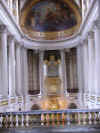 This picture is taken on the second floor, where Louis XIV attended mass
daily.
This picture is taken on the second floor, where Louis XIV attended mass
daily.
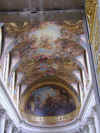 This chapel ceiling is just one example of the many magnificently painted
ceilings throughout the château.
This chapel ceiling is just one example of the many magnificently painted
ceilings throughout the château.
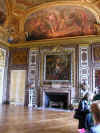
The Diana Drawing Room served as a vestibule for the State Apartment where
visitors would wait for an audience during the day. In the evening, it would
serve as a billiards room. Louis XIV was a past master of the game. The painting
on the ceiling over the fireplace depicts The Sacrifice of Iphigenia.
 The Peace Drawing Room was where the queen would hold court as well as play her
public games. Every Sunday, Maria Leczinska, wife of Louis XV, gave concerts of
sacred or secular music. It also served as Marie Antoinette's (wife of Louis
XIV) game room.
The Peace Drawing Room was where the queen would hold court as well as play her
public games. Every Sunday, Maria Leczinska, wife of Louis XV, gave concerts of
sacred or secular music. It also served as Marie Antoinette's (wife of Louis
XIV) game room.
 Until 1684, the Mars Drawing Room was used as a guardroom, hence the
military-inspired decor. Later, it was used for music and games in the
evenings.
Until 1684, the Mars Drawing Room was used as a guardroom, hence the
military-inspired decor. Later, it was used for music and games in the
evenings.
 The
Council Chamber was where King Louis XIV held his Councils every day at the end
of the morning. For more than a century, all important political decisions were
made in this room, including the decision in 1775 to participate in the War of
Independence with the colonies of America.
The
Council Chamber was where King Louis XIV held his Councils every day at the end
of the morning. For more than a century, all important political decisions were
made in this room, including the decision in 1775 to participate in the War of
Independence with the colonies of America.
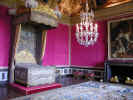 The Mercury Drawing Room was the State Bedchamber of the State Apartments. The
state bed, hung with gold and silver brocade to match the walls, was closed off
by a silver balustrade with eight candelabras. This furniture was melted down by
order of the king to meet war expenses. The bed in this picture was added when
Versailles was turned into a museum.
The Mercury Drawing Room was the State Bedchamber of the State Apartments. The
state bed, hung with gold and silver brocade to match the walls, was closed off
by a silver balustrade with eight candelabras. This furniture was melted down by
order of the king to meet war expenses. The bed in this picture was added when
Versailles was turned into a museum.
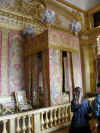 In
1701, the King's Bedchamber was added in the center of the château, with a
window overlooking the entrance and a view of the rising sun. It was the setting
of several ceremonies and a large part of the daily life of the king, including
where he usually ate lunch. He also granted audiences in this room. The king was
washed, brushed, and dressed in front of a crowd of several hundred
people.
In
1701, the King's Bedchamber was added in the center of the château, with a
window overlooking the entrance and a view of the rising sun. It was the setting
of several ceremonies and a large part of the daily life of the king, including
where he usually ate lunch. He also granted audiences in this room. The king was
washed, brushed, and dressed in front of a crowd of several hundred
people.
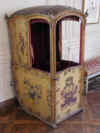 When the people of the court were not riding in carriages, they were carried in
a sedan.
When the people of the court were not riding in carriages, they were carried in
a sedan.
 The
Hall of Mirrors has seventeen windows overlooking the garden, with seventeen
mirrors reflecting the light of the windows on the other wall. The Treaty of
Versailles was signed in this room, and it is still used today for important
state events. You can see a beautiful panorama view
of this room. Click on view and then the Hall of Mirrors on the right side of
the page. You'll also see a nice view of the King's Bedchamber. This is the
official site of the château.
The
Hall of Mirrors has seventeen windows overlooking the garden, with seventeen
mirrors reflecting the light of the windows on the other wall. The Treaty of
Versailles was signed in this room, and it is still used today for important
state events. You can see a beautiful panorama view
of this room. Click on view and then the Hall of Mirrors on the right side of
the page. You'll also see a nice view of the King's Bedchamber. This is the
official site of the château.
 The Hall of Battles has thirty-five paintings portraying fourteen centuries of
French history through its military victories. There are eighty-two busts of the
most famous French soldiers who died in combat.
The Hall of Battles has thirty-five paintings portraying fourteen centuries of
French history through its military victories. There are eighty-two busts of the
most famous French soldiers who died in combat.
 We
actually are there! Be sure to
visit our page on the beautiful garden of Versailles. The pictures we
have here are only a small part of the garden and château. We'll add more to
this collection after our future visits. Meanwhile, additional photos can be
seen at another site.
We
actually are there! Be sure to
visit our page on the beautiful garden of Versailles. The pictures we
have here are only a small part of the garden and château. We'll add more to
this collection after our future visits. Meanwhile, additional photos can be
seen at another site.
Hoog, Simone and Béatrix Saule, Your Visit to
Versailles. Versailles, France: Éditions Art Lys, nd.

